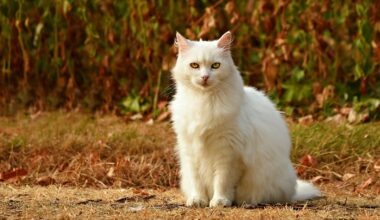Training Techniques to Overcome Exercise Resistance in Cats
Engaging a cat in regular physical activity can be a challenge. Unlike dogs, cats may not readily chase after balls or participate in outdoor play. One effective strategy to encourage more exercise is creating an enticing play environment. Ensure the space is stimulating, featuring climbing walls and scratching posts. Incorporate different heights and platforms to entice your cat’s natural curiosity and instinct to climb. Interactive toys can also support an active lifestyle. Toys that mimic prey, such as feather wands and laser pointers, can intrigue cats to jump, chase, and move. Ensure these toys are safe and suitable for cat play to prevent any injuries. You may start by engaging your cat in short play sessions, gradually increasing the activity duration as they become more comfortable. To make sessions enjoyable, monitor your cat’s behavior to understand their preferences. Employ treats and praise to reward your cat for participation. Ultimately, finding the right balance between exercise and enjoyment will lead your cat to be more physically active. Remember, every cat is unique, so tailor activities to suit their specific needs and preferences.
Another technique is to establish a routine that promotes daily exercise. Cats are creatures of habit, so implementing regular playtime sessions helps create a sense of expectation. Try to choose consistent times throughout the day for interactive play. This routine can help your cat associate certain times with activity and engagement. Along with a set schedule, provide a variety of toys to sustain your cat’s interest over time. Rotate the toys in and out, as introducing new or forgotten items can reignite their engagement and excitement. Additionally, offer them puzzle toys or food-dispensing toys that require movement for them to get their treats. These formats can challenge their clever minds while prompting them to be physically active. Furthermore, temporary changes in environment, such as rearranging the furniture, will spark interest and curiosity, prompting exploration and movement. These changes can lead to increased activity, keeping your feline friend entertained and engaged. Always observe your cat’s behavior to ensure that they enjoy these changes and don’t feel stressed. The goal is to integrate exercise in a fun and enjoyable manner, reinforcing their willingness to participate.
Interactive Games and Gadgets
Utilizing interactive games and technology can enhance your cat’s exercise routine significantly. Numerous gadgets are available today that can encourage play and activity without requiring your constant participation. Automating play can benefit both busy cat owners and shy cats that may be hesitant to engage in conventional play. For example, consider investing in electronic toys that mimic the movements of small animals, attracting your cat’s attention. These devices often offer various settings, allowing you to adjust the level of play and keep things fresh. You could also install interactive cat furniture, such as tunnels or climbing towers. These structures not only provide an exercise route but also a personal playground, engaging them creatively. Additionally, mobile apps designed for cats are gaining popularity; these use visual and auditory stimuli to capture a cat’s interest. The independence provided by these gadgets allows cats to engage when the mood strikes them, promoting exercise without a structured session. Be sure to supervise your cat when using automated toys initially, ensuring safety and proper use. Ultimately, the right technology can create a unique play experience for your cat.
Social interaction can also play a pivotal role in encouraging exercise. Introducing another cat into a household can spark increased physical activity as they engage in friendly play. However, this decision must be approached with caution, ensuring both cats are compatible to avoid stress. When two cats bond well, they can chase, wrestle, and engage in play, significantly increasing their overall activity levels. The companionship often leads to more profound physical and emotional stimulation. If adopting another cat isn’t feasible, consider frequent social interaction with other pets or even supervised outdoor activities, like leash training. Gradually introducing your cat to a harness and leash can allow for brief outdoor excursions, which can be thrilling and enriching experiences. You can also opt for collaborative play – where you play along with your cat to keep things lively. Try playing games that require both you and your cat’s participation. This can strengthen your bond while making exercise a fun and shared experience. Remember to be patient with your cat as they adjust to these new social dynamics and always prioritize safety when introducing new play styles.
Using Treats as Motivation
Integrating treats into exercise routines can be a powerful motivator for many cats. Positive reinforcement helps associate playtime and exercise with rewards. Using healthy treats, you can encourage your cat to start exercising with the promise of a tasty treat after participation. While using treats, be mindful of portions so that it does not affect your cat’s overall nutrition balance. Moderation is crucial; small bits of treats can go a long way in rewarding behavior without contributing to obesity. You can create a game where your cat earns a treat every few minutes of active play, thus enticing them to keep moving. It’s essential to select treats that your cat loves, ensuring they remain engaged throughout the activity. Additionally, try varying the reward system by using short training sessions and activities that lead to a treat. For example, hiding treats around their play area can prompt exploration and movement, channeling their natural hunting instincts while rewarding them. A strategic approach to treat rewards can go a long way in making exercise a desirable activity instead of a chore.
Monitoring your cat’s weight and overall health is crucial in their exercise journey. Tracking progress provides insights into how effective training methods and activities are for their well-being. A cat’s ideal weight varies based on breed and age, so acknowledging these differences is vital. Regular check-ups with your veterinarian can offer tailored fitness recommendations based on your cat’s unique needs. Adjusting exercise routines may be necessary depending on changing factors such as health, age, or preferences. Weight management is especially important, as obesity can lead to severe health issues in cats. As you work through the right exercise regimen, keep a record of activities and your cat’s response to them. If your cat seems resistant, it might necessitate a change in approach to encourage engagement. Sometimes, the reluctance to exercise can stem from underlying health issues; therefore, consulting with a veterinarian is always a wise choice. Remember to provide encouragement throughout the process, maintaining a positive and supportive environment. The right dedication to consistency and monitoring will foster a healthier lifestyle for your cherished feline companion.
Creating a Fun and Safe Environment
Your home environment significantly influences your cat’s willingness to engage in exercise. Creating a stimulating atmosphere encourages exploration, leading to more physical activities. You can achieve this by incorporating various toys, scratching posts, and cat trees into your home. Ensure these items are strategically placed around the house, giving your cat opportunities to jump, climb, and explore. Additionally, consider rotating toys, which helps keep their interest fresh and invites curiosity. Use scent and texture to intrigue your cat; toys that involve interesting fabrics or catnip can draw nervous cats out of their shells. Decluttering the play area is essential, as obstacles can lead to injuries, discouraging activity. Keeping pathways open allows freedom of movement, making play easier and more enjoyable. Set up cozy spots for rest nearby, ensuring your cat has safe areas to retreat to between activities. Providing a stimulating environment doesn’t just increase exercise opportunities, but also enriches your cat’s life. As they explore their surroundings, they build on their confidence and motivation to engage in physical movements, ultimately promoting overall wellness.
Lastly, being patient and understanding while encouraging your cat’s fitness is essential. Each cat has a unique personality and comfort zone, and recognizing these traits will better tailor training techniques. Some cats might take longer to engage or adopt new activities, and that’s perfectly okay. Celebrate any small victories made, such as your cat showing interest in play or responding during sessions. It’s important to respect your cat’s limits; forcing them into prolonged activities might backfire. When they express resistance, switch to different approaches to see what resonates better with them. Consistency is key, but it should be blended with enjoyable elements to make exercise enticing. A positive emotional connection leads to better participation rates. Implementing gradual changes and allowing your cat to adapt can foster a better environment for physical activity. Always keep their health and happiness priorities in mind. Over time, your efforts will help create a more active and playful feline companion. Your patience and creativity in exercises will yield rewarding benefits for both you and your cat’s overall health and happiness.


